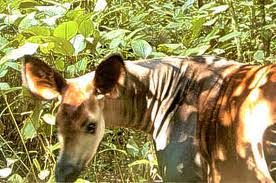Okapi
Okapis (Okapia johnstoni) are members of the animal kingdom in the Class mammalia that reside in the Democratic Republic of the Congo (not that other Republic of the Congo). Okapis are famous for being the "outcasts" in the Animal Kingdom. With striking features such as unnecessary horns, racing stripes, and a cow's tail, many animals used to laugh and call it names, similar to the bullying and harassment experienced by Rudolph the Red-Nosed Reindeer.
Creation and Discovery[edit | edit source]
The okapi was first discovered in 1901 by Harry Johnston. At first, the renowned British explorer thought he was stuck in a terrible dream. No such luck, as the existence of this creature was a reality. When Johnston brought the okapi back to scientists, they claimed it was related to the giraffe, an observation later attributed to LSD. Other scientists, however, have different theories. Although looking similar to the zorse or hebra, it actually involves a giraffe in the breeding process. In 1937, the first okapi was bred in America in the Bronx Zoo. Scientists and zookeepers (as well as innocent civilians) watched a giraffe, a horse, and zebra performing an intimate action, the first threesome-in-captivity. Sixteen months later, the genetic makeup of an okapi was discovered. Within the three animals that produced the okapi, the giraffe was the only female and ultimately the carrier of the young okapi calf. Giraffes traditionally drop their young twelve feet at birth, and the "mother" did so to the bred-in-captivity okapi, no doubt accounting for its repugnant facial and bodily structure.
Features[edit | edit source]
Each of the three animals involved gave the okapi some of its striking features. The long tongue given to the okapi was the work of the giraffe. It can be from 12 to 18 inches long. The okapi uses its grotesque tongue for all of the following:
- eating the high leaves on trees
- giving disgusting signals to human passers-by
- stealing ice cream cones from young children
- flipping off leopards.
Habitat[edit | edit source]
The okapi only lives in one country, the Democratic Republic of the Congo. It was believed to once inhabit the entire Ituri Forest in Africa, but its despise for humans caused it to become isolated in one country. Unfortunately, the herd chose the wrong country, one continually at war and subject to the worst overcrowding on the continent of Africa. To prevent future human attacks, okapis have begun to pierce their tongues for the insertion of swords and other metal weapons. When asked about human threats by Barbara Walters on The View, Kesho the okapi from the Philly Zoo, stated:
| “ | Nnnnngggooorrrr rrnnooogg errrngon gneroonnnnnnn | ” |
And that's a quote.
Photograph[edit | edit source]
In 2008, a rare photograph of an okapi was captured for the first time in fifty years. The okapi glared at the photographer, but the photo still sold for $437 on Craig's List. Today, the photo is probably in the hands of a rare collector (or one of the guys from Pawn Stars) without a college degree.
Okapi Habits[edit | edit source]
The okapi usually reflects its gestures by means of its tongue, but can also demonstrate its feelings using its tail. When an okapi begins to wag its tail, it is expressing anger. This tail even has the power to knock down a fainting goat when angry. Fainting goats developed their habit of purposely collapsing because of their fear of an okapi's tail. Okapis also have skin-covered horns called ossicones, but they serve no purpose. If its skin didn't cover the horns, okapis wouldn't be ranked last on the World's Most Harmful Animals (WMHA) list. These horns can be used for:
- impressing other okapis during breeding season
- headbutting trees and deserving humans
- smashing giant onions
- being a wannabe two-horned unicorn (twonicorn)


